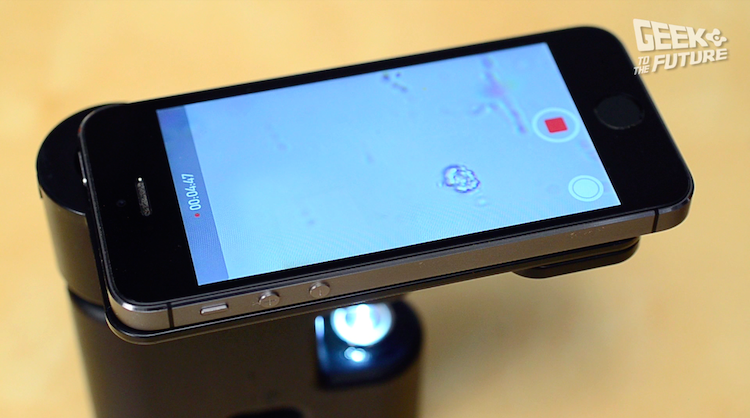MicrobeScope: staring at the ciliates

Ebola virus is a scary thing. You can’t see it with a normal microscope with all your desire - the size of the dangerous infection does not exceed 80 nanometers. However, a microscope in this case is useless. Even if the particularly impressionable residents of Guinea, Liberia and Sierra Leone begin to use it as an amulet.
Nevertheless, the benefit of the invention of the Dutchman Anthony van Levenguk, whatever one may say, but still is. And if you combine this device with modern devices - for example, a smartphone or tablet - you can get something like the MicrobeScope gadget, which successfully collected 120 thousand on Kikstarter without $ 12. Note, of the $ 10,000 originally requested.
It’s hard to believe, but this very “microbe-scope” was in our hands. The creators of the gadget were in such a hurry to deliver it to everyone who donated a pretty penny for the project that you can notice from the assembly - we have before us not a serial copy, but a piece product: some joints are rather roughly processed, and the sealant around the objective lens collects fine dust well. But this did not stop us: we simply could not refuse to test and review the device first in the post-Soviet space.

Its formula is simple: portable, one might even say marching ... no, better - a tactical (sarcasm!) Device with a crazy 800x magnification can be used independently, or in conjunction with smartphones or tablets.

MicrobeScope
Price: $ 115-135 (Kickstarter)
Magnification: 800x
Depth of field: 35 microns
Field of view: 190 microns
Batteries: 2x AAA
Using a microscope is so simple that there is not even an instruction in the box. First, turn on the backlight (inside, two AAA batteries that power the LED), with the attached micropipette we collect the test sample in a liquid state and drip directly onto the lens. That's it - you can observe the Brownian movement directly into the eyepiece, occasionally adjusting the ciliates with the tip of the same pipette.



Now add the technology. We take the cheapest smartphone (we had the iPhone 5S at hand), put it on a special stand, combine its camera with the microscope eyepiece and ... a wonderful picture opens! It becomes even more wonderful if you take a tablet. By the way, Apple devices of the latest generations are also convenient because they have a Slo-Mo mode, using which, you can make too sharp microorganisms move slowly and powerfully.
Remembering the biology lessons, you will probably ask: what about all these glasses with drugs? We answer: no way! The creators have simplified the design of the classic microscope.
Naturally, simplicity is associated with a number of limitations. So, the hair, hair of pets and pestles-stamens of plants will have to be slipped either with tweezers, or - what there - right with your fingers. And since making them fit snugly against a microscopic lens is, say, not so simple, you will have to add a fair amount of agility and considerable patience to research courage.



However, a set of disposable slides is still available here. So red blood cells, if there is a suitable donor, you can still consider. But, we’ll immediately warn you: without additional devices, this is quite difficult to do (in every sense).
Oddly enough, but 800x is not always good. A fixed increase will allow you to examine in detail the hairs on the fly’s foot, but it will not be able to give an idea of the structure of its body.
By the way, one of the most common requests to developers on the project page is to recommend what you can see through MicrobeScope. Indeed, looking at live beer and no less than live yoghurts quickly gets bored. Although this sounds unappetizing, they recommend scraping from the inside of the cheek or removing plaque from the tooth. After that, it remains to dilute the “bio-sample” with water and observe the rich microflora, which is “always with you”. Another option that can completely replace swamp slurry is water from a vase with long-standing flowers.
Since the lens does not have any protection, on the one hand it must be protected from damage, and on the other hand, do not forget to thoroughly wipe it after use.
Finally, not every smartphone or tablet is suitable for working with MicrobeScope. The fourth and fifth “iPhones” and “iPads” ideally fit on a stand. But with devices whose main camera is located in the center, you may have to suffer.




Today you can’t find anything on the microscopic equipment market - the same Yandex.Market offers more than two thousand options. But given the size, magnification power, ease of operation, as well as work with smartphones and tablets, we can safely say that this microscope has no analogues.
An indispensable tool for all lovers of microvoyeurism so far only available to participants in raising money for the implementation of the project. As we were told in MadRobots , which provided us with a test copy of MicrobeScope, the company is considering selling the device through its own stores. Well, the president of 4D Optical, Nick Bratt, secretly told us that the mass production of the gadget could begin in the coming months.
PS Video illustration of the above - video "MicrobeScope: how to see the Ebola virus in the iPhone?" on our YouTube channel Geek to the Future
